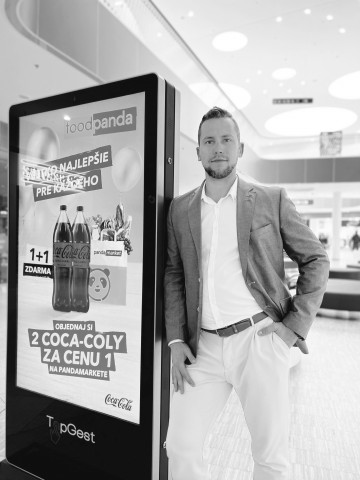Forbes Slovakia, 2nd of November 2022

The Lurity brand has been on the market for six years. In that time, nearly 2,300 campaigns have been run through their medium and the company has expanded into three countries. Tomas Tiefenbach, founder of the unique digital out-of-home medium Lurity, says that the future lies in going digital and replacing classic billboards with LED boards.
You manage an ambitious company that combines the classic out-of-home (OOH) medium with the flexibility of digital. What is special about your digital out-of-home advertising?
Our original intention was to create interactive Artificial Intelligence (AI)-powered storefronts that would learn how to best engage customers based on computer vision, POS data, and hundreds of thousands of interactions. From there, it was just a step to turning the project into an interactive advertising platform where anyone who wanted to communicate any message quickly and effectively could advertise. The first location involved in the Lurity advertising network was the Bory Mall shopping centre in Bratislava.
However, we had to abandon cameras and facial recognition during the corona. As with any business, the veils made life more complicated for us and it was no longer possible to work with data about the age and gender of people who were looking at our medium - the digital screen. However, this didn't detract from the innovation of our platform, as our clients proved to appreciate the business and user benefits of the medium other than just measuring viewership. The main benefits they perceive are the quick selection and purchase of digital advertising space via our self-service portal, transparent pricing policy and also real-time tracking of campaign progress with the option of self-service campaign visual replacement.

Who is your medium for? Who makes up the largest part of your clientele and who should definitely be interested in a digital out-of-home solution?
More than fifty percent of our clients are large advertisers serviced by media agencies. For these clients, we mainly provide convenient planning via the portal and nationwide or Slovak and Czech advertising coverage. Lurity's network includes connected screens in more than forty frequented shopping malls, attractive LED boards on busy thoroughfares, hospitals, fitness centres, various shops and stores. Currently, we have a novelty and that is the network of eighty screens of the Slovak Post or COOP Jednota, which we are still expanding.
The OOH medium is finally being seen as an essential part of the media mix because it is proving to work.
For smaller clients, we are particularly interesting because of our transparent pricing - all areas with prices are on our website, so they can plan the campaign on their own without having to exchange dozens of emails with the area operator and negotiate the price for a long time.
In addition, they can change the visuals or video campaigns themselves at any time, so if they want to change the visuals, for example, they don't have to elaborately and retrospectively re-tape the billboard, they simply upload the visual to the portal, we approve it within fifteen minutes, and it starts appearing in the campaign.
You are active in three countries and your ambitions obviously don't end there. How will your project develop? What else will it offer to marketers and brands?
Of course, with Lurity we have big ambitions to grow abroad. So far we have been perfecting the product to make it ready for expansion, but now we are ready and going global.
In cooperation with TapGest, another innovative company that develops digital-signage players, we are extending the features of conventional screens with interactive applications that have a wide range of marketing applications. For example, where before the connection of our technology it was only possible to play plain image and video campaigns, once connected to the network the screens are able to play live-feed campaigns in which data changes in real time, which is appreciated by clients with active content.

How do you see the overall development of the market in the OOH segment going forward? What news are waiting for us?
Classic paper billboards will gradually go by the wayside. This is mainly due to pressure from cities and residents to suppress visual smog. However, the volume of advertising will not decrease, but on the contrary - it will increase due to the growth of the economy. In the absence of technological progress, these market mechanisms would cause the cost of billboards to be enormous and smaller advertisers would be forced to switch to other advertising formats. The only solution to this situation is digitalisation - replacing, for example, five billboards with a single LED board on which five to ten, or even twenty, advertisers can present themselves.
This trend is well visible in Western European countries and in the United States, where digitisation is faster. Advertisers have more money, popularly speaking, thanks to the greater purchasing power of the population, so ads are more expensive and digital technologies have an order of magnitude lower return.
In addition, surveys of brands' media spend show that investment in out-of-home and digital OOH in particular is growing continuously, and trends suggest that DOOH will make up more than a third of OOH budgets by 2025. Out-of-home media is finally being seen as an essential part of the media mix because it is proven to work: such well-placed advertising works as an accelerator of consumer buying behaviour. All of this puts digital OOH advertising on the plane of a highly effective medium, which is why we should pay even more attention to it than we already do.
The full article published in Forbes can be found at the link: https://www.forbes.sk/digitalna-out-of-home-reklama-ako-buducnost-ucinn…